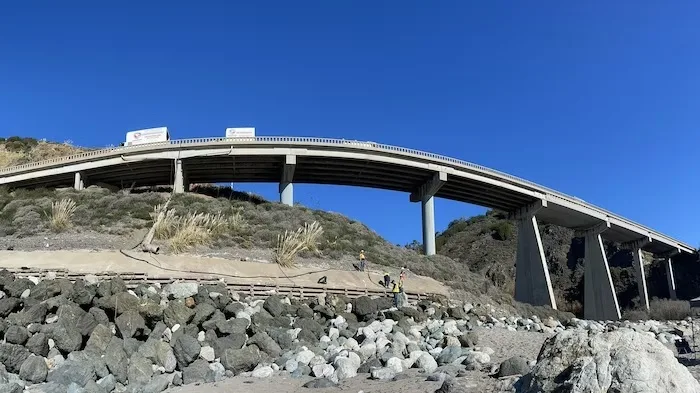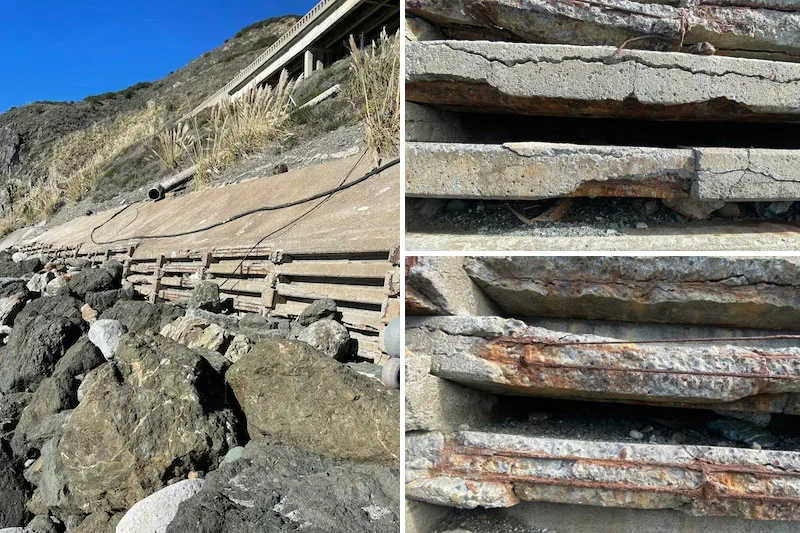In the ever-evolving symphony of nature’s forces, atmospheric rivers emerge as awe-inspiring conductors, weaving an invisible, dynamic tapestry in the sky. These meteorological marvels, often stretching thousands of kilometers, are channels of atmospheric moisture that traverse continents, leaving their indelible mark on the landscapes they touch. While their primary performance occurs high above, their impact resonates far below, especially when they interact with vital lifelines of infrastructure, such as bridges.
As bridges bridge gaps between distant shores and connect communities, they too find themselves entwined in this cosmic ballet of atmospheric rivers. When these torrential conduits unleash their power, the humble bridges are put to the ultimate test, standing as steadfast guardians against the formidable deluge of elements. The impact of atmospheric rivers on bridges is a dance of engineering ingenuity and nature’s unyielding energy, intertwining in a spectacle of structural strength and resilience.
What are Atmospheric rivers?
Atmospheric rivers are long, narrow corridors of intense moisture in the atmosphere that transport vast amounts of water vapour from the tropics to higher latitudes. When these meteorological phenomena collide with mountainous regions or encounter topographical barriers, they release copious amounts of rainfall and snowfall, often leading to flooding, erosion, and landslides. The impact of atmospheric rivers on bridges can be significant, as the excessive and prolonged precipitation can overwhelm river systems, causing floods that may submerge roads leading to bridges, erode bridge foundations, and subject the structures to additional stress, potentially compromising their stability and safety.
The National Oceanic and Atmospheric Administration explains that these are long, narrow regions in the atmosphere that carry water vapour outside of the tropics. They say that normally they are capable of carrying “the equivalent to the average flow of water at the mouth of the Mississippi River” (roughly 593,000 cubic feet per second, while strong atmospheric rivers can transport up to 15 times that).

Atmospheric rivers wreaking havoc upon Limekiln Creek Bridge
In regard to atmospheric rivers, in March 2023, California experienced an extraordinary weather phenomenon, with 12 consecutive atmospheric rivers causing extensive soil saturation. This series of atmospheric rivers in California led to extensive soaking and saturation of the soil, severely impacting the Limekiln Creek Bridge
The Limekiln Creek Bridge is a 6-span prestressed precast I girder bridge built in 1957, and is scheduled for replacement as part of a highway realignment plan.
As a consequence of the saturated soil, the crib wall supporting the slope around the bridge’s northern abutment suffered damage. Stormwater and tidal activity had washed away the fines in the aggregate and cobbles within the crib wall, leaving behind voids and gaps. With the crib wall compromised, there were grave concerns about the stability of the hillside, posing a significant risk to the integrity of the Limekiln Creek Bridge.
The dire situation prompted an emergency response, and the California Department of Transportation (Caltrans) District Five swiftly called upon EagleLIFT Inc., a specialized engineering contracting company renowned for lifting, leveling, and soil stabilization solutions in California and Nevada. The company founded in 1995 by retired Air Force colonel Donald J. Moody, is a reputable engineering contractor renowned for its expertise in lifting, leveling, and soil stabilization solutions. The company primarily employs expanding foam to lift pavements and roadways and offers void-filling services. In recent years, they have faced challenges related to rising ocean levels and increased tidal action, leading to issues with washouts behind sea walls.

EagleLIFT addressing the challenges for Limekiln Creek Bridge repair
EagleLIFT acted swiftly to address the emergency situation caused by a void behind a seawall at Limekiln Creek Bridge. The stormwater and tidal forces had washed out the fines in the aggregate and cobbles placed between boulders within the crib walls. This erosion raised concerns about the stability of the hillside, as the crib wall was the only thing holding it back. If the conditions continued to worsen, many feared that the crib wall might fail, leading to a potential landslide.
Despite having a backlog of work, EagleLIFT recognized the urgency of the repair and responded immediately. Cliff Frazao, the president of EagleLIFT, explained, “Excessive rainfall, stormwater, and king tides caused erosion of the soils and fines in a 160-ft. section of the concrete crib wall. The Caltrans geotechnical engineers needed a solution that would preserve the wall’s integrity and avoid the need for a costly replacement.”

The repair work of Limekiln Creek Bridge
To begin the repair, EagleLIFT assessed the size and scope of the voids by drilling 5/8-in. holes vertically and horizontally, and then inserting 1/2-in. steel probes. They used an expanding polyurethane product called Strata-Fill from NCFI’s Geotechnical Polyurethanes Division to fill the voids. HILTI roto-hammers were used to drill and drive the steel tubes.
Normally, reconstructing a hillside would require a lengthy road closure, but EagleLIFT managed to complete the repair with minimal disruption. They hired a qualified traffic control subcontractor with flaggers and only had to close one lane, finishing the project 50% under budget in about two days during normal working hours.
Accessing the site posed a special challenge due to the steep 45 to 50-degree bank. The EagleLIFT team had to scale down the hillside to gain access to the crib wall. They parked the truck and pump at the top, with hoses hanging down some 200-ft. below.
Utilising Strata-Fill – The Right Polymer Structural Polymer
EagleLIFT chose structural polymers for bridge repair due to their ability to enhance structural strength, resist corrosion, and provide durable repair solutions. These lightweight yet robust materials offer flexibility and crack resistance, mitigating the effects of dynamic forces and temperature changes. Their excellent adhesion to various substrates allows seamless integration with existing bridge components, minimizing downtime and traffic disruptions during repairs.
The selected solution was an expanding polyurethane product called Strata-Fill, manufactured by NCFI’s Geotechnical Polyurethanes Division, specifically designed for filling large voids. It is specifically designed as a two-part structural polymer to fill large voids rather than for lifting. It differs from typical roadway lifting foams that generate high heat during expansion.
EagleLIFT successfully pumped around 5,000 lbs. of Strata-Fill through the steel rods into the voids. Frazao mentioned, “It follows the path of least resistance and finds voids we didn’t even know were there. One void behind that wall was large enough to stand up inside.” He also highlighted the additional benefits of Strata-Fill, “It’s lightweight, so it doesn’t add extra pressure on the soil, and its low exothermic reaction temperature means it generates very low heat during the polymerization reaction, making it ideal for closed spaces like these voids where you don’t want overheating or a smouldering fire.”
NCFI manufactures polyurethane foam systems for various applications, including spray foam insulation, geotechnical, marine flotation, and more. The company’s flexible foams cater to furniture, transportation, bedding, carpet underlay, and packaging needs.
Frazao, drawing on his 25 years of experience, emphasized the importance of choosing the right product for specific lifting and void-filling work. Different types of polymers are suitable for different tasks, depending on factors like the type of soil and the load involved. “One foam does not do everything. Some people think that and learn the hard way,” he says. “That’s where the experience comes into play – knowing which polymer will serve the customer the best and give the result that they’re looking for.”
“Compared to alternative methods of fill, like lightweight concrete, cellular concrete, or even straight concrete, the use of polyurethanes reduces that load bearing weight on questionable soils,” says Patrick Burchett, NCFI Polyurethanes Technical Manager.
Originally developed for the pipeline industry, Strata-Fill evolved over the years to suit various geotechnical applications, including concrete lifting. NCFI also offers other products in the same weight range and a hydrophobic system for void filling or pipe abandonment that reacts in the water.
While the repair job did not require a specific compressive strength, Strata-Fill provides a 44-psi compressive strength or about 8,000 lbs. per square foot. Once cured, Frazao attested that it becomes nearly as hard as concrete without causing unintended damage due to excessive expansion pressure.
Another key advantage of Strata-Fill was its environmental considerations, as it was used near the ocean. Products used in such situations must pass stringent environmental tests to avoid water or soil contamination. NCFI is undergoing NSF-61 testing, a water safety standard, to ensure their products comply with all requirements.
Frazao compared this project to repairing a car, where addressing small issues early on can save substantial costs in the long run. He acknowledged that while the repair is a temporary fix, it will last until the construction of a new bridge over Limekiln Creek, as Strata-Fill has been tested to have a 50-year lifespan.
Conclusion
EagleLIFT’s rapid response and application of the suitable structural polymer, Strata-Fill, played a pivotal role in preserving the Limekiln Creek Bridge. The company’s ability to choose the right solution for the specific situation, coupled with the polymer’s exceptional performance, provided a cost-efficient and reliable outcome. Through their expertise and innovation, they averted a potential disaster and safeguarded vital transportation infrastructure for years to come.
Reference: forconstructionpros.com



